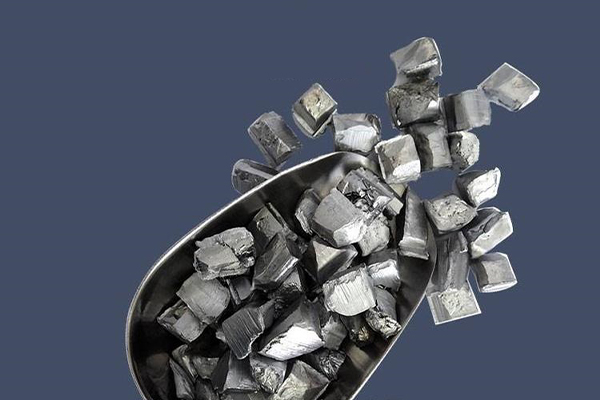Vanadium is a metal element, element symbol V, silver-gray metal, in the periodic table of the elements belongs to the VB group, atomic number 23, atomic weight 50.9414, body-centered cubic crystals, the common valence of +5, +4, +3, +2. Vanadium's melting point is very high, refractory metal, ductile, hard, non-magnetic. It is resistant to hydrochloric and sulphuric acids and has better gas, salt and water corrosion resistance than most stainless steels.
Vanadium (V)
1、Improve the heat strength.
2, vanadium can significantly improve the welding performance of ordinary low carbon low alloy steel.

Vanadium is a high melting point refractory rare metal and its main product forms are: vanadium pentoxide, vanadium trioxide, ferrovanadium and vanadium nitride. Of these, vanadium pentoxide and vanadium trioxide are the predominant vanadium oxides in actual production, and they are the main raw materials for the production of subsequent vanadium products such as ferrovanadium, vanadium nitride and vanadium carbides.
Applications of Vanadium
Vanadium is an important alloying element used mainly in the steel industry. Vanadium-containing steels have excellent properties such as high strength, high toughness and good wear resistance, and are therefore widely used in machinery, automobiles, shipbuilding, railroads, aviation, bridges, electronic technology, the defense industry, etc. Their use accounts for about 85% of vanadium consumption, with the iron and steel industry accounting for the largest proportion of vanadium use. Demand from the iron and steel industry has a direct impact on vanadium market conditions. Approximately 10% of vanadium is used in the production of titanium alloys for the aerospace industry. Vanadium acts as a stabilizer and reinforcing agent in titanium alloys, giving them good ductility and plasticity.
Around 85% of vanadium metal is added to steel production in the form of ferrovanadium and vanadium-nitrogen alloys to improve the strength, toughness, ductility and heat resistance of steel. High strength alloy steels containing vanadium are widely used in the production and construction of oil/gas pipelines, buildings, bridges and rails. Vanadium-containing high-strength alloy steels include: high-strength low-alloy (HSLA) steel (consolidated); HSLA steel plate; HSLA steel sections; HSLA strip; advanced high-strength strip; rebar for construction; high-carbon steel wire rod; steel rails; tool and die steels; and others.

The effect of vanadium on the microstructure and heat treatment of steel
① Vanadium and iron can form a continuous solid solution, strongly narrowing the austenite phase region.
② Vanadium and carbon, nitrogen, oxygen have a very strong affinity, mainly in the form of carbides or nitrides, oxides in steel.
③ The hardenability of steel can be adjusted by controlling the austenitizing temperature to change the amount of vanadium in the austenite and the amount of undissolved carbides as well as the actual grain size of the steel.
④ As vanadium and carbon are able to form stable refractory carbides, the steel maintains a fine crystalline organization at higher temperatures, which greatly reduces the steel's susceptibility to overheating.
The effect of vanadium on the mechanical properties of steel
① A small amount of vanadium can make grain refinement, toughness increased.
② vanadium content is high, resulting in aggregated carbides, so that the strength is reduced, carbide precipitation in the crystal will reduce the room temperature toughness, so in most of the steel content is not high.
③ After appropriate heat treatment to make carbides diffuse precipitation, vanadium can improve the high-temperature endurance strength and creep resistance of steel.
④ Vanadium carbides are the hardest and most wear-resistant of the metal carbides. Diffusely distributed carbides can improve the hardness and wear resistance of tool steels.
The effect of vanadium on the physical, chemical and process properties of steel
① Adding vanadium to iron-nickel alloys can increase the magnetic permeability after appropriate heat treatment. Adding vanadium to permanent magnet steel can increase the magnetic coercivity.
② Adding sufficient amount of vanadium to fix carbon in vanadium-carbon compounds can greatly increase the stability of steel against hydrogen at high temperature and pressure, which is suitable for the manufacture of reactors. In stainless acid-resistant steel, vanadium can improve the resistance to intergranular corrosion.
③ The presence of vanadium oxides is detrimental to the high temperature oxidation resistance of steel.
④ Vanadium-containing steels can significantly increase deformability at lower processing temperatures.
⑤ Vanadium improves the welding properties of steel.

Application of vanadium in steel
Vanadium is widely used in ordinary low alloy steel, alloy structural steel, spring steel, bearing steel, alloy tool steel, high-speed tool steel, heat-resistant steel, hydrogen-resistant steel and low-temperature steel.
② vanadium reserves in the earth is not high, although the price of silicon, manganese, titanium, molybdenum slightly more expensive, but the amount of steel in general is not more than 0.5% (mass fraction, in addition to high-speed tool steel), so you can promote the use of. Vanadium has now become one of the common elements in the development of new steel grades.